“The McLaughlin Strat was stolen after Beck absentmindedly left it in an open-top hot rod”: The highlights of the Jeff Beck guitar auction – from the story of Seymour Duncan’s Tele-Gib hybrid to his legendary Oxblood Gibson Les Paul
Christie’s Jeff Beck Auction offers a revealing look at numerous iconic instruments from the guitar hero’s entire career – from the Yardbirds to Johnny Depp
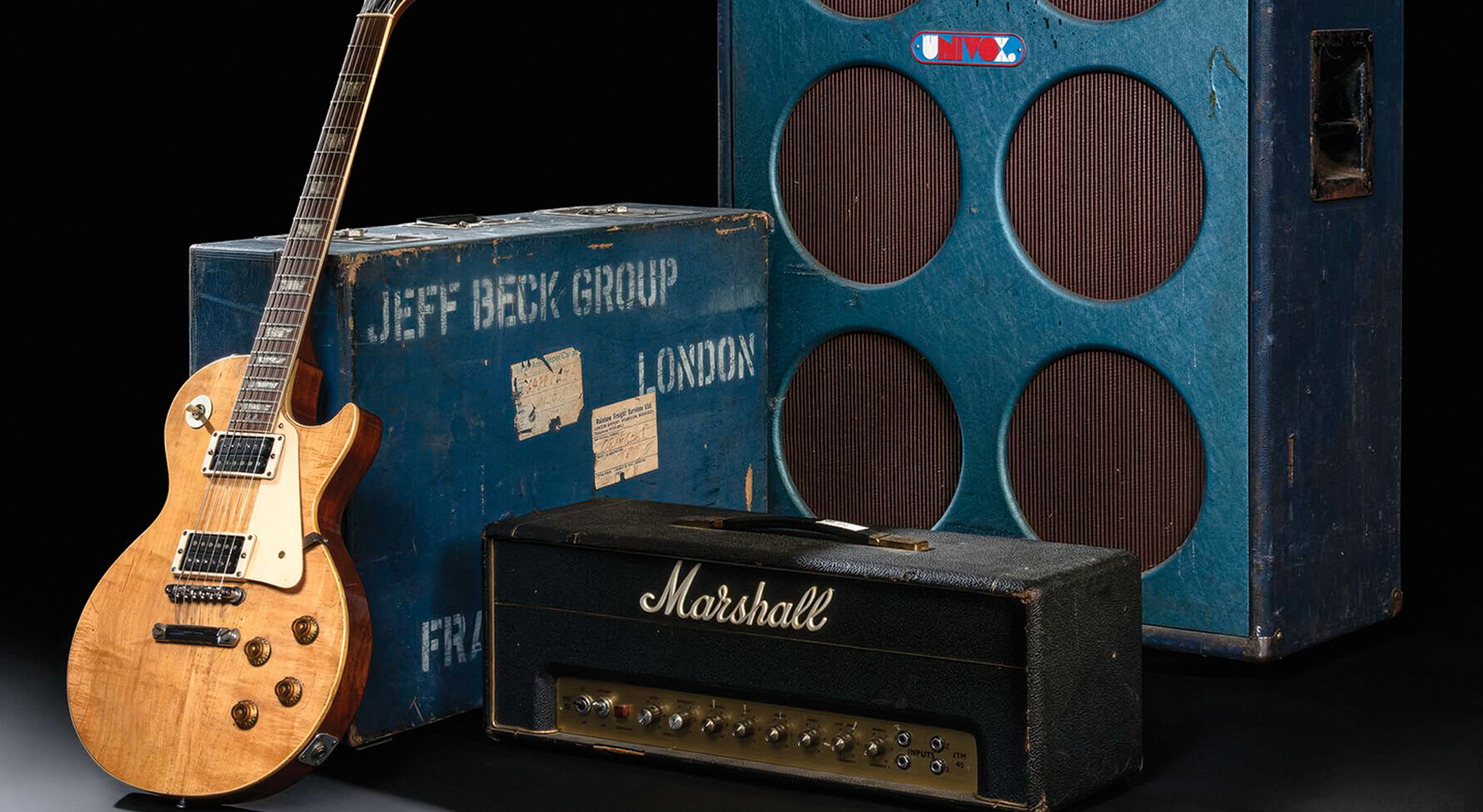
Most successful guitarists inevitably become guitar collectors, eventually amassing dozens or even hundreds of instruments during their careers.
Many famous and acclaimed guitarists have owned some of the world’s most impressive collections, such as legendary veterans Eric Clapton, David Gilmour, Mark Knopfler and Pete Townshend, as well as relative newcomers like Joe Bonamassa and Slash, who acquired some of the rarest and most highly desirable vintage instruments.
These hoarding proclivities were expertly spoofed in the timeless rock mockumentary comedy This Is Spinal Tap when Nigel Tufnel showed off his guitar collection to director Marty Di Bergi and refused to let Di Bergi even look at a mint, unplayed Seafoam Green 1963 Fender Bass VI that still had its hang tags. But even though actor Christopher Guest based Tufnel on Jeff Beck, this was one of the few scenarios that wasn’t very much like Beck at all.
Beck certainly owned more than his fair share of guitars, but his collection was more about well-worn, used and abused tools of his trade than untouched trophies, consisting almost entirely of items that he played on stage and in the studio on a nearly daily basis.
Recently, Beck’s wife Sandra felt that his guitars had sat idle too long and she decided that they belong in new homes with players who can continue to make music with them.
On January 22, 2025, about 90 guitars and string instruments and various amps, pedals and other music wares from Beck’s collection – a total of 130 lots – will be sold in auction by Christie’s in London.
“These guitars were his great love,” said Sandra Beck. “But after almost two years of his passing it’s time to part with them as Jeff wished. After some hard thinking, I decided they need to be shared, played and loved again.
Get The Pick Newsletter
All the latest guitar news, interviews, lessons, reviews, deals and more, direct to your inbox!
“It is a massive wrench to part with them but I know Jeff wanted for me to share this love. I hope the future guitarists who acquire these items are able to move closer to the genius who played them.”
The variety of gear in the auction covers the guitarist’s entire career from his early days in the Yardbirds through his final shows with Johnny Depp.
In addition to truly iconic guitars – like his 1959 ‘Yardburst’ and 1954 ‘Oxblood‘ Les Pauls, his custom ‘Tele-Gib assembled by Seymour Duncan, a 1954 Strat gifted to Beck by Steve Marriott and various prototypes of his Fender Jeff Beck Stratocaster signature model – the auction also includes numerous surprises like the Chapman Stick he was seen playing in the late ’70s, various acoustic guitars and Fender basses that he wasn’t known for playing, a 1957 Telecaster signed by the rhythm guitarist for Gene Vincent and His Blue Caps Paul Peek and several lap steels.
Several of the more unusual and obscure instruments were likely gifts given to Beck over the last two decades of his life.
Two highly coveted Klon Centaur pedals are up for bidding as well as the custom J. Rockett Archer ‘klone’ pedals that replaced them in his rig (a very strong endorsement if there ever was one) along with individual pedals, entire pedalboard rigs and even custom Marshall floor wedges.
Numerous Marshall, Fender tweed and Magnatone “Becktone” amps are also in the mix, along with the Fender Princeton II and Twin Reverb II amps he used to record 1989’s Guitar Shop.
The following are a few highlights of the most famous and fascinating items from Christie’s Jeff Beck auction.
c. 1959 Gibson Les Paul Standard (‘Yardburst’)

Along with the ’50s Fender Esquire that Beck bought from John Maus, this Les Paul Standard was one of the guitarist’s most prized acquisitions while he was with the Yardbirds in the mid ’60s. It originally had a sunburst finish, black pickguard and a pair of highly coveted double-cream bobbin PAF humbuckers.
Jeff eventually stripped off the sunburst finish to expose the natural grain and color of its maple top. During the late ’60s, an unscrupulous repairman replaced the cream PAFs with a pair of later-model Gibson humbuckers, which upset Beck and drove him to buy another 1959 Les Paul from future Cheap Trick guitarist Rick Nielsen.

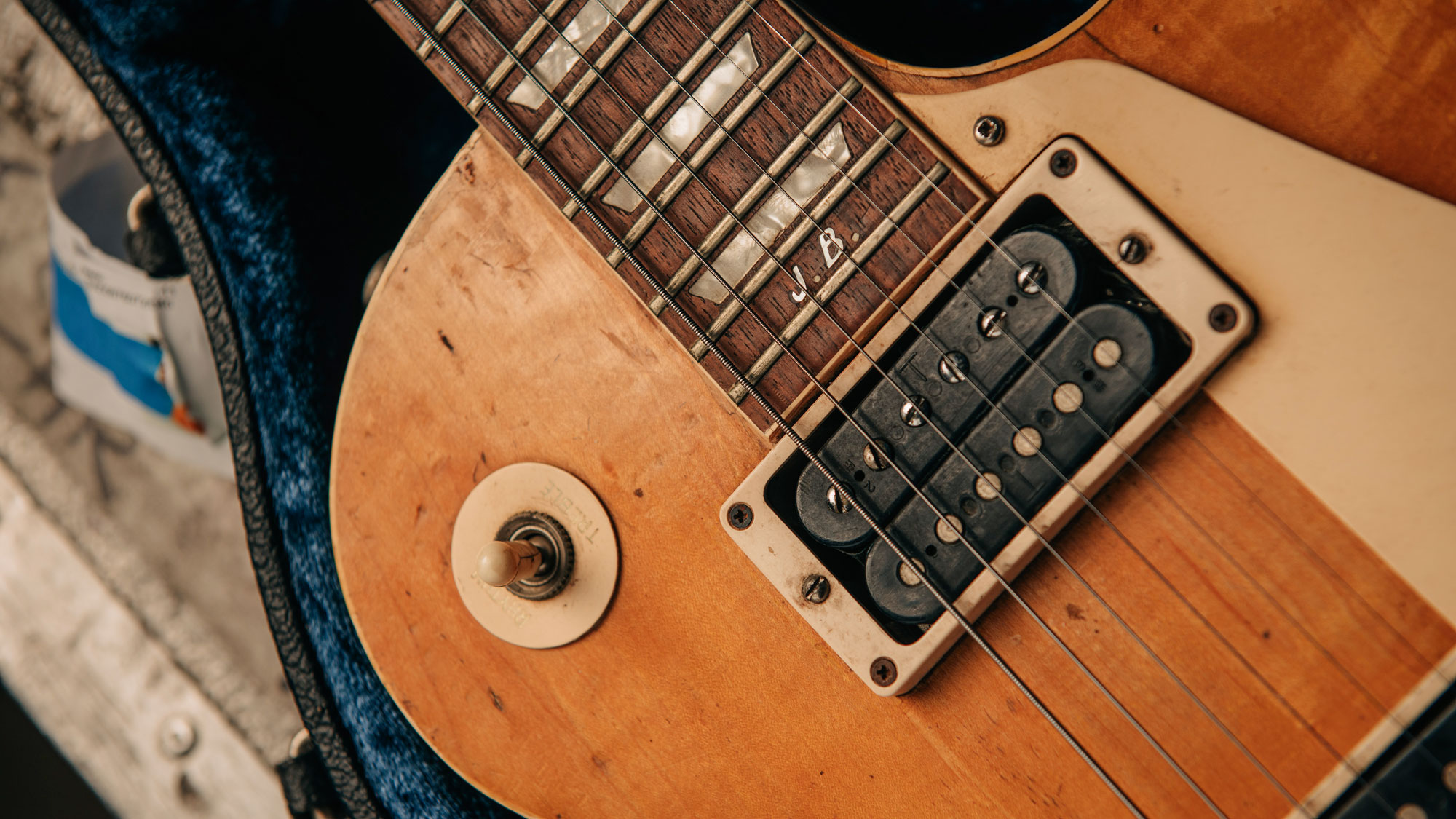
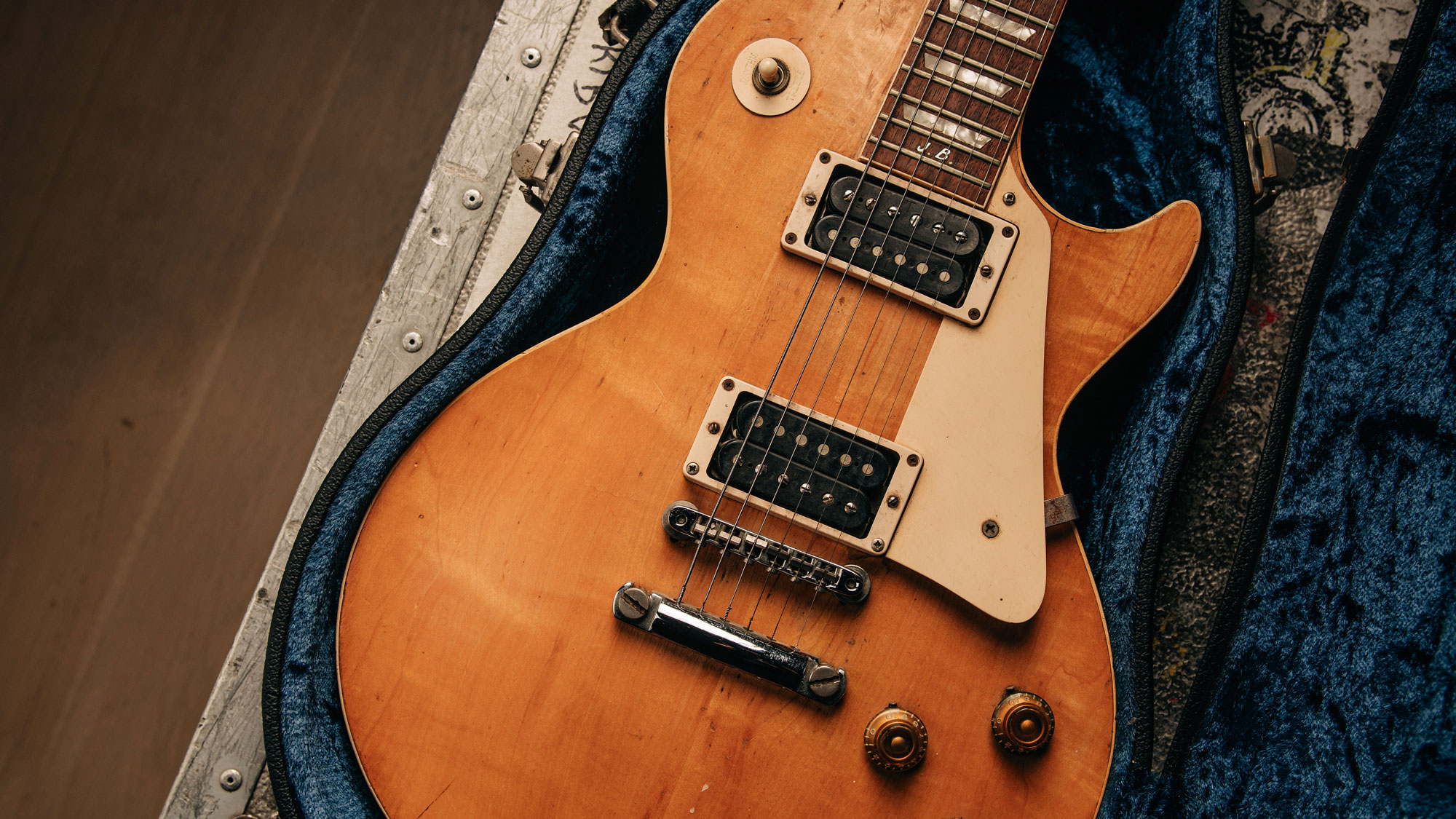
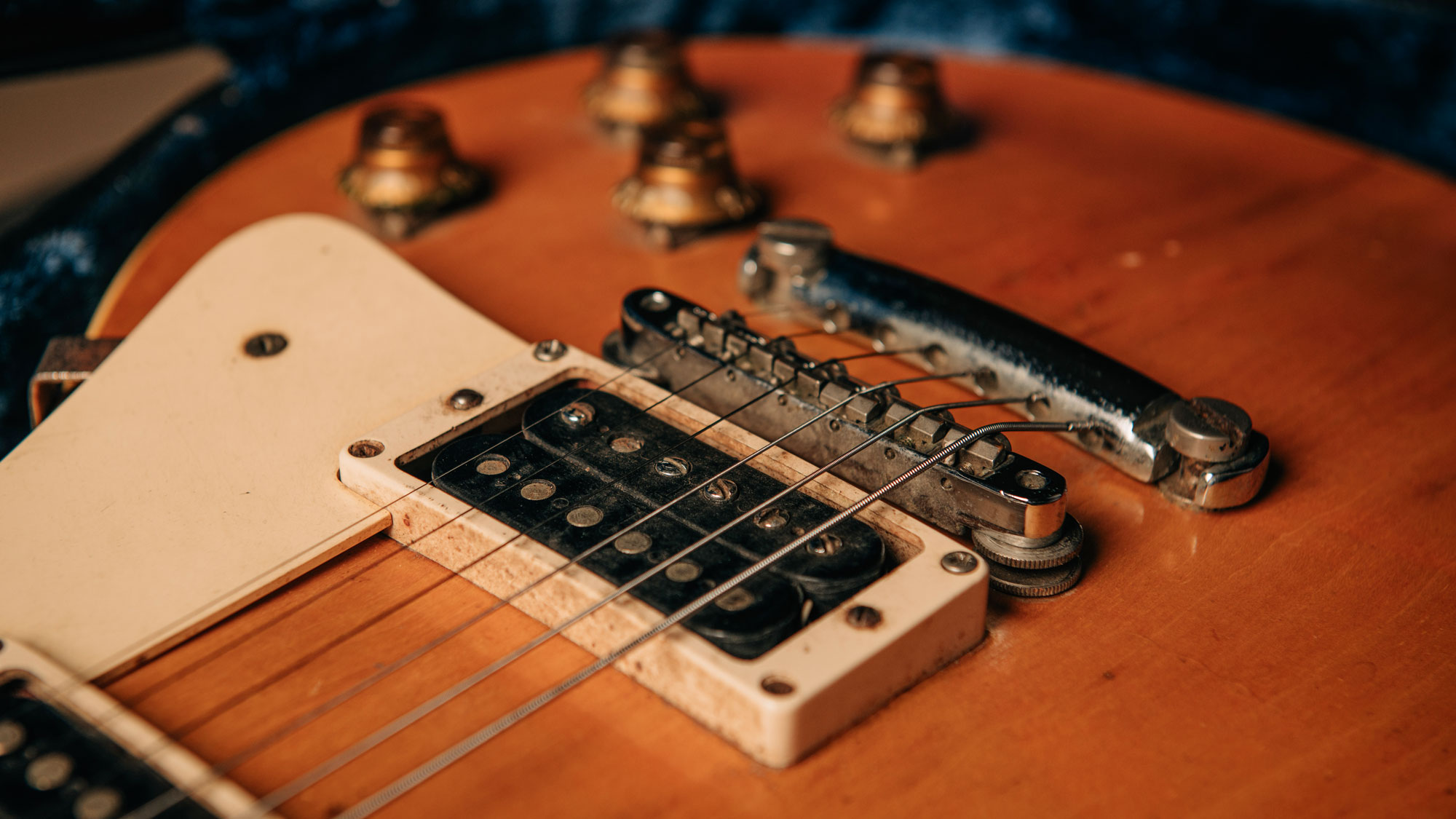
In the early ’70s, after he broke the Yardburst’s neck, a craftsman built a new neck featuring a vintage Gibson logo and L-5-style “flower pot” inlay on the headstock and the initials “J.B.” between the 21st and 22nd frets.
This guitar appeared on numerous important Jeff Beck recordings during the ’60s, including the Yardbirds’ Roger the Engineer/Over Under Sideways Down album, the Jeff Beck Group’s Truth album and the Beck’s Bolero single.
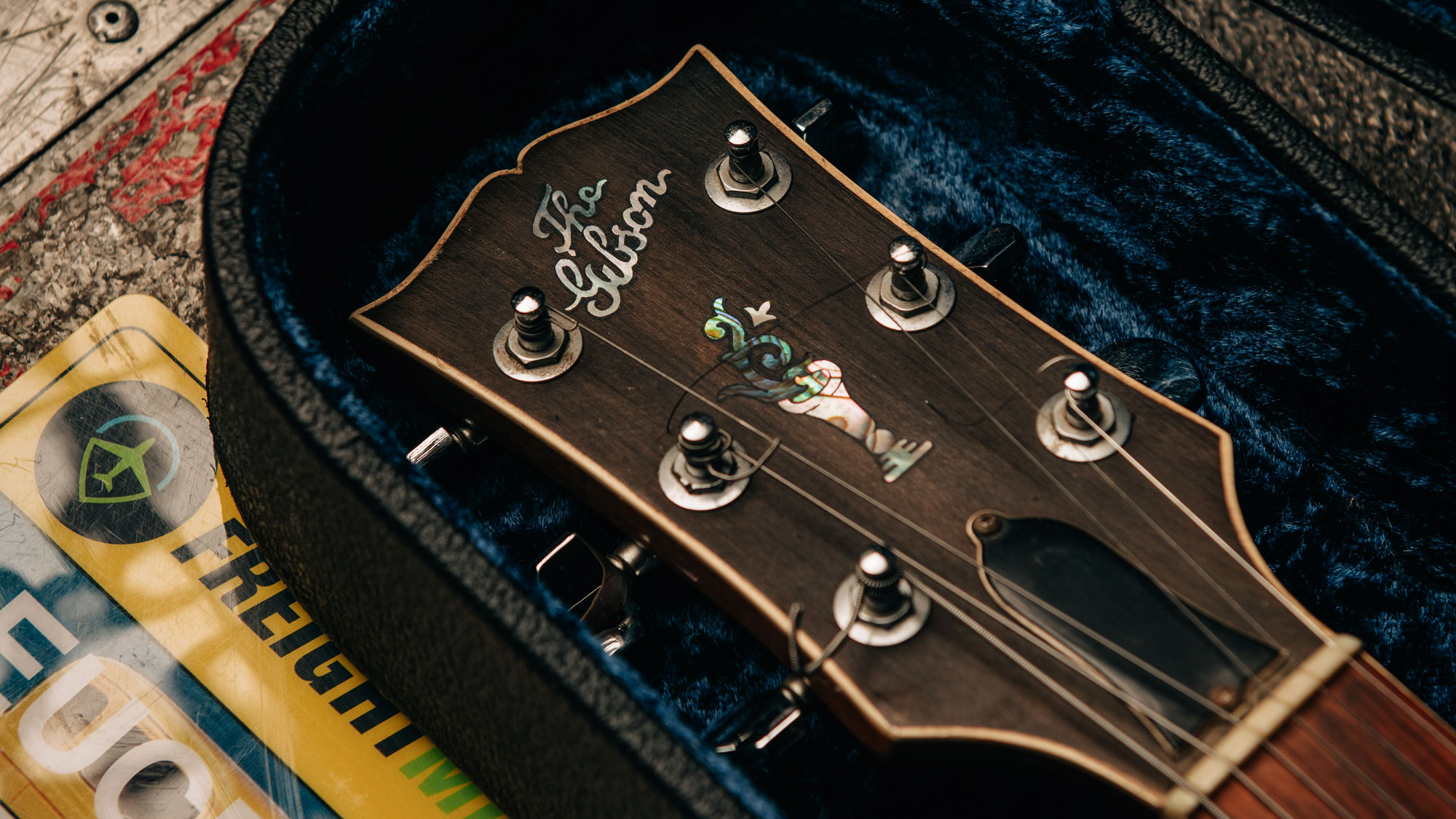
1954 Gibson Les Paul Model (‘Oxblood’)
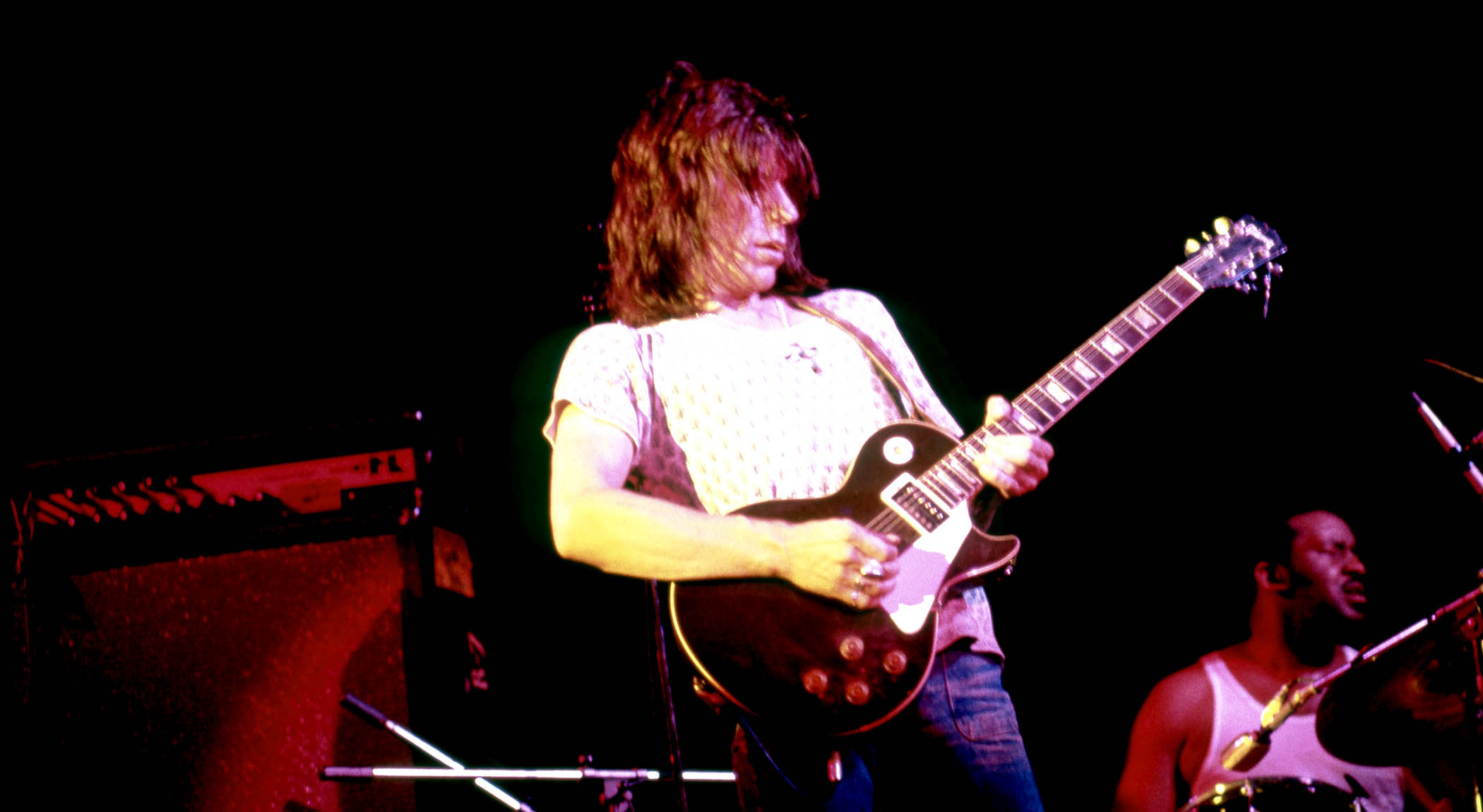
This guitar enjoys immortal iconic status, thanks to its depiction on the cover of Beck’s best-selling album, Blow by Blow. Jeff bought this 1954 Les Paul from a fan and friend named Buddy Davis in Memphis in November 1972.
The Les Paul had already undergone several modifications when Beck acquired it, which included the replacement of its original P90 single-coil pickups with Gibson humbuckers and a refinish job with a distinctive deep dark brown color that inspired its ‘oxblood’ nickname.
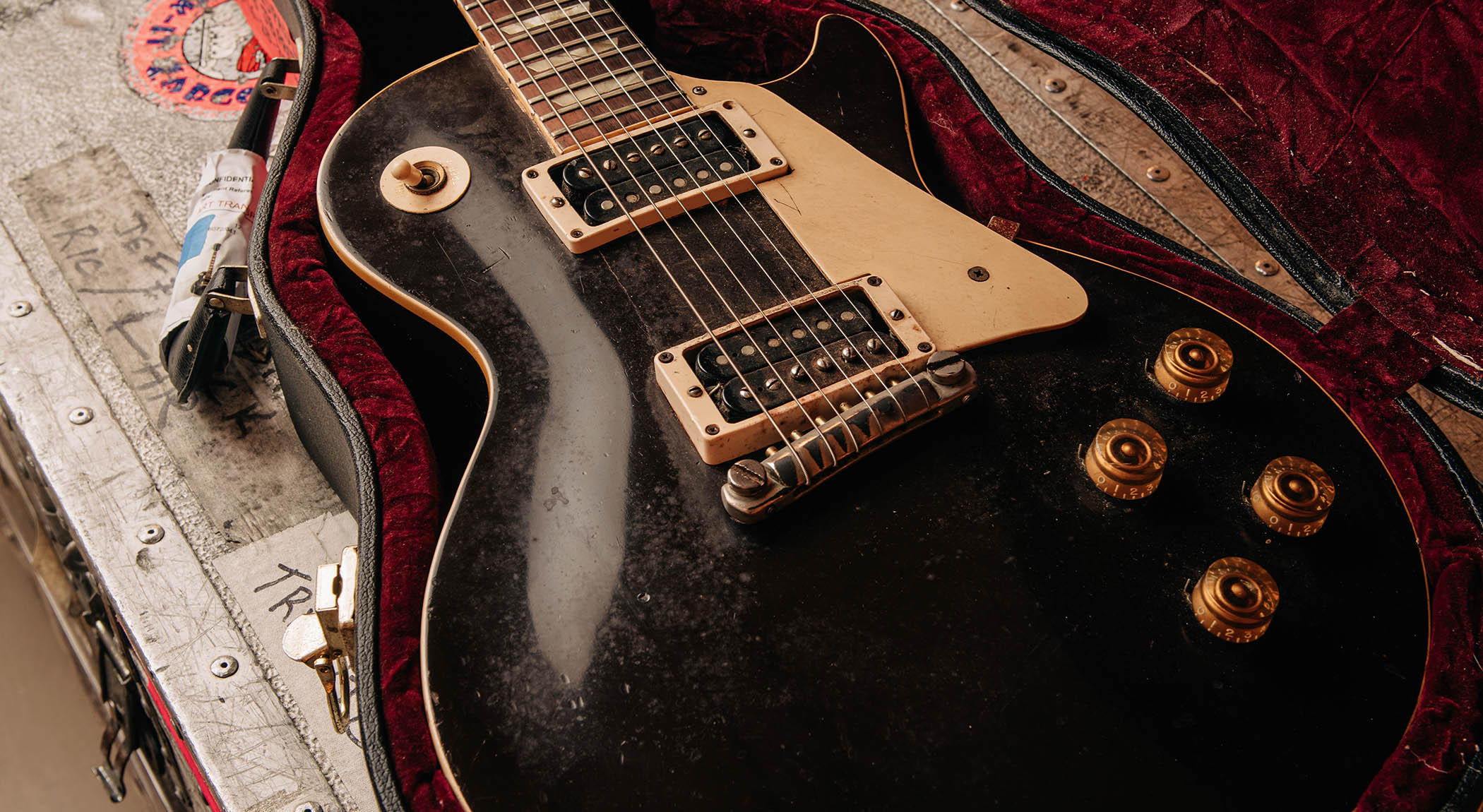
Beck was photographed frequently on stage with the oxblood Les Paul with Beck, Bogert & Appice, and it remained his main instrument through the mid ’70s, featuring prominently on his Blow by Blow album and 1975 tour with John McLaughlin.
In 2007, Gibson made a highly detailed limited-edition replica of the Oxblood Les Paul, and one of the prototypes and a production model are also in the auction.
Custom Tele-Gib 1959 Fender Telecaster
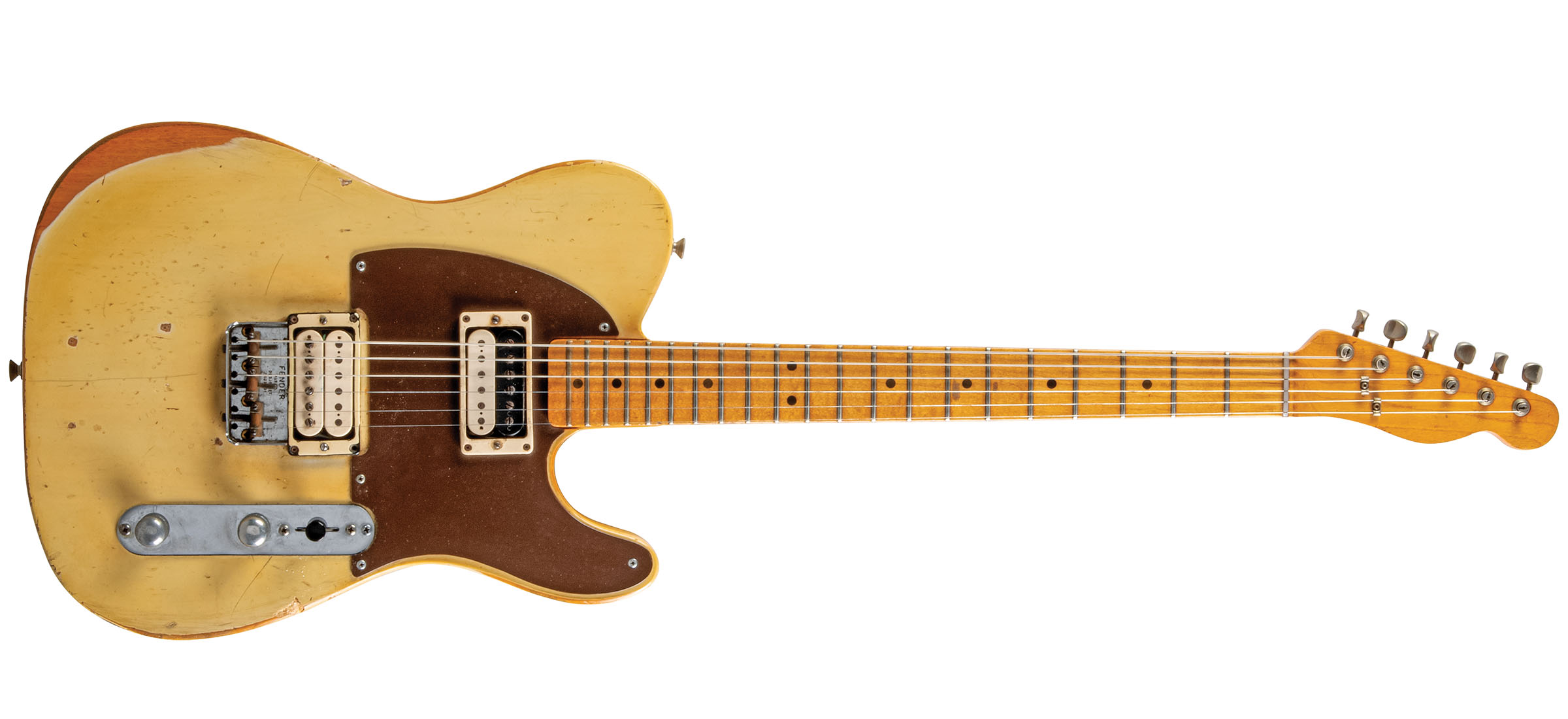
In early 1974, when Jeff was in CBS Studios working on Beck, Bogert & Appice’s ill-fated second studio album, Seymour Duncan approached the guitarist with a custom Telecaster/Les Paul hybrid instrument that he had assembled.
The zebra bobbin neck and dual-cream bridge humbuckers were originally broken PAFs that Duncan salvaged from a 1959 Flying V that once belonged to Lonnie Mack
It started as a butchered 1959 Tele with a rosewood neck, but Duncan routed out larger cavities for full-size humbucking pickups and replaced the battered rosewood fretboard with a maple fretboard and installed Gibson Les Paul frets. Duncan cut an early ’50s Tele bridge in half to accommodate a bridge humbucker, and he cut a new pickguard.
Perhaps the most important element of Duncan’s custom Tele/Les Paul hybrid is its pickups. The zebra bobbin neck and dual-cream bridge humbuckers were originally broken PAFs that Duncan salvaged from a 1959 Flying V that once belonged to Lonnie Mack.
Duncan rewound the pickups, in the process creating the prototypes for his JB and JM model humbuckers. The finished guitar was nicknamed the ‘Tele-Gib’ for its blending of Telecaster and Gibson features.
Duncan traded the Tele-Gib for Beck’s iconic Yardbirds Fender Esquire, which Beck bought from John Maus of the Walker Brothers in the summer of 1965. Beck didn’t seem to mind the trade (at first) and later that year he used the Tele-Gib while recording Blow by Blow, most notably playing it on Cause We’ve Ended As Lovers.
Beck also appeared on stage with this guitar during his 1981 performances alongside Eric Clapton for The Secret Policeman’s Other Ball shows and subsequent concert film.
c. 1966-67 Marshall Model 1987 JTM45 MK IV Super Tremolo
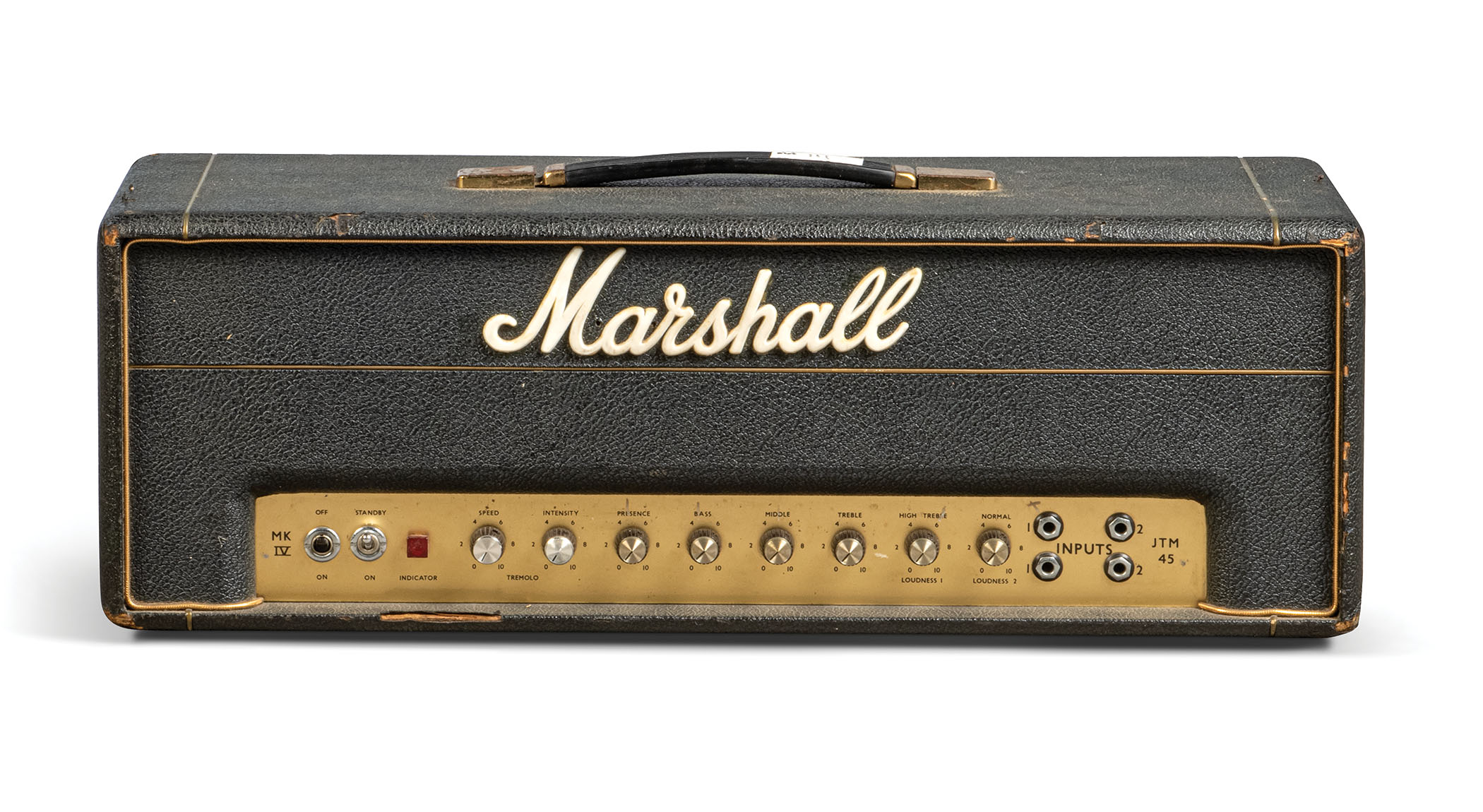
If you look closely at photos of Beck’s early concerts with the Jeff Beck Group in 1968 and 1969, you’ll probably notice Beck plugged into one or more Marshall heads with eight control knobs instead of the usual six. These were Super Tremolo heads, and the two extra knobs controlled the tremolo effect’s speed and intensity settings.
This Marshall Super Tremolo head is an unusual and rare early example, housed in a ‘small box’ cabinet and marked JTM45 and MK IV on the front panel. Typically, the JTM45 MK IV designation was seen on the chassis for the Marshall combo model known as the ‘Bluesbreaker’ combo that Eric Clapton used to record the Beano album with John Mayall and the Bluesbreakers.
It’s highly possible that this is the amp that Beck used in the studio to record tracks for the Truth album in May 1968.
1953 Fender Champion 600
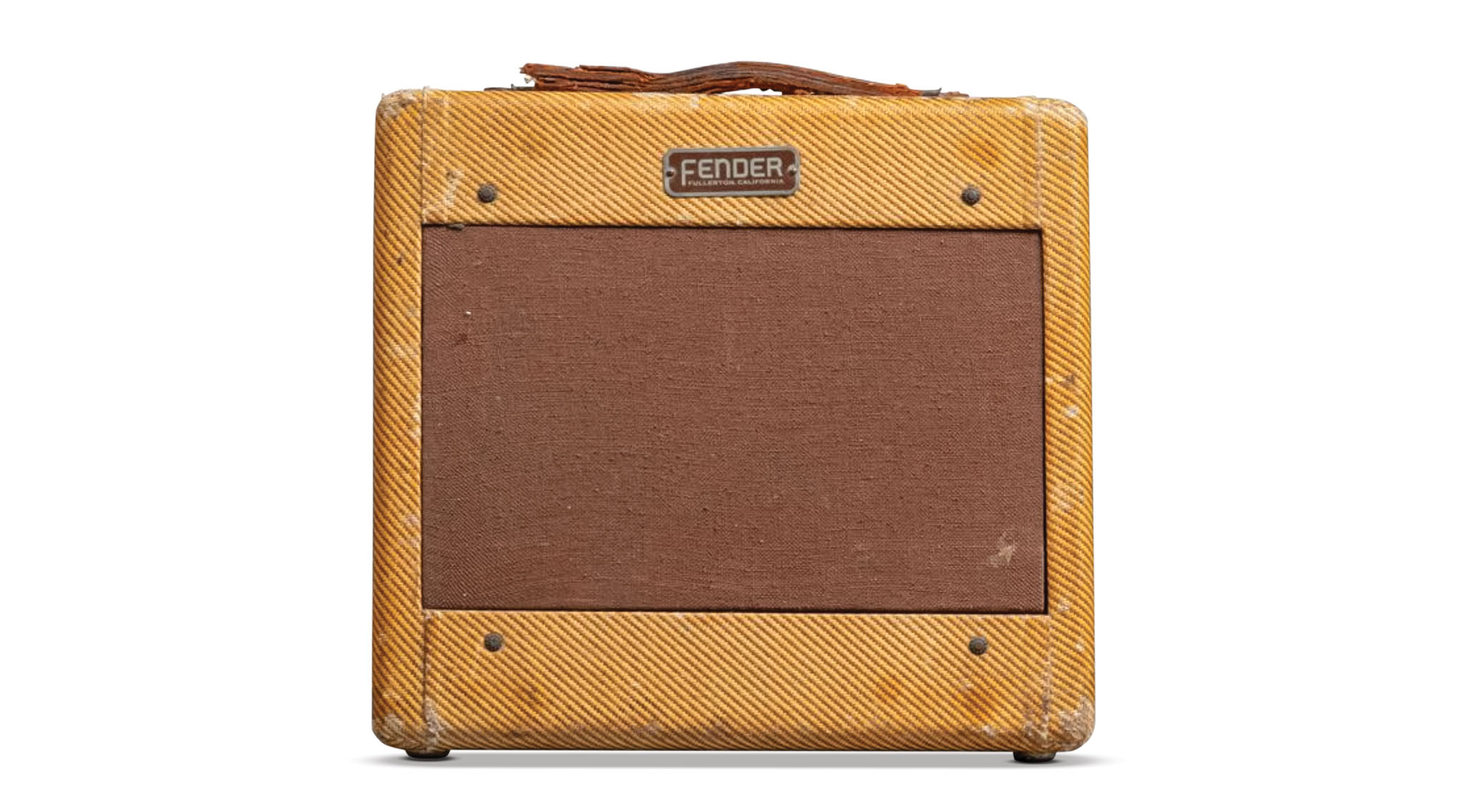
Although Beck is usually associated with using loud Marshall stacks on stage like the ones he was seen with in the late ’60s with the Jeff Beck Group, he often used much smaller amps in the studio.
One can’t get much smaller or more primitive than the 1953 Fender Champion 600 seen here, but surprisingly this was his main amp while recording his 2010 Emotion & Commotion album. During this period Beck even performed concerts using small 15-watt Fender Pro Junior 1x10 combos, with his Marshalls only appearing for show.
1977 Roland GS-500 Guitar Synthesizer Controller
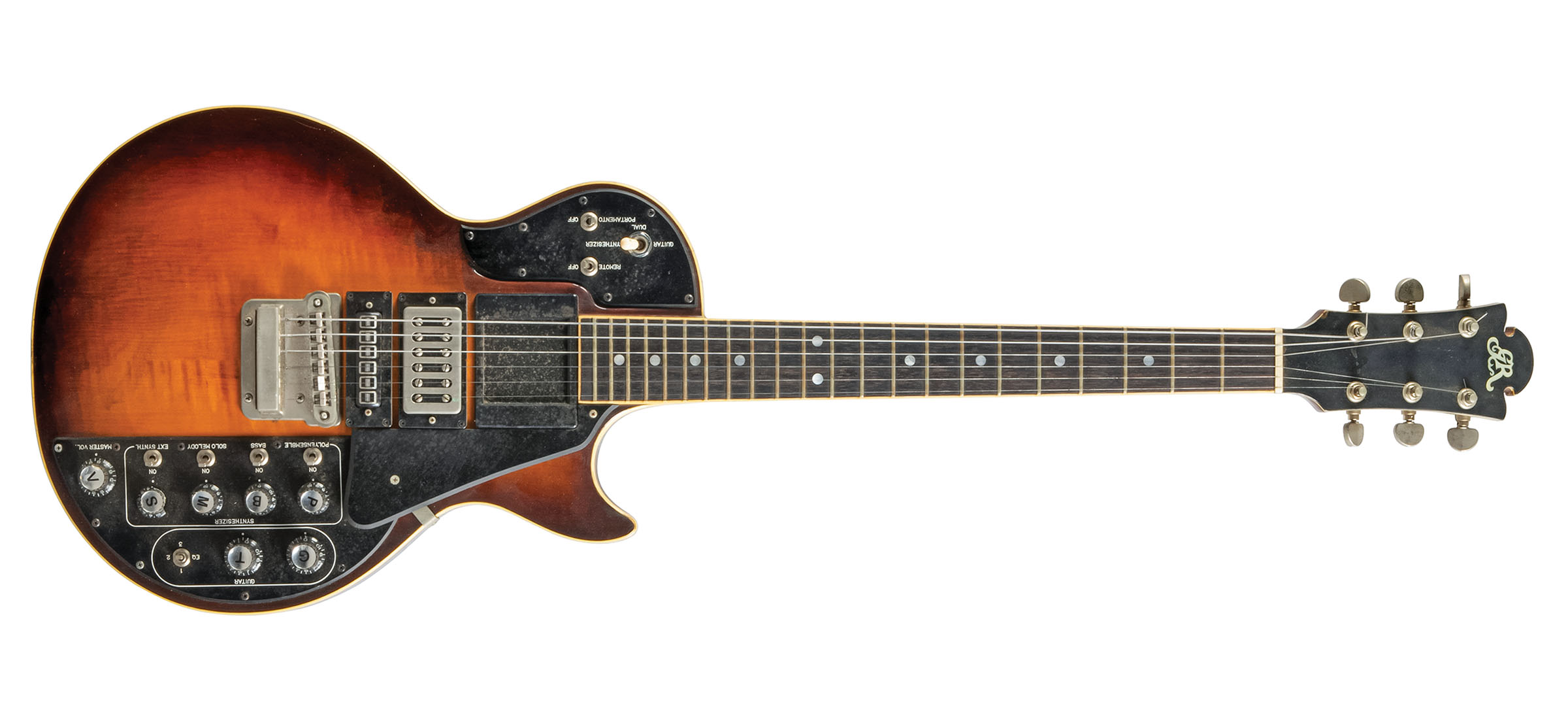
Although Beck has seemed like a staunch traditionalist and even a minimalist at numerous points of his career, he could also be wildly adventurous with his gear. One example is the Roland GS-500 Guitar Synthesizer Controller seen here, which appeared on Jeff Beck’s 1978 tour in Japan.
This guitar, built by Japan’s famed Fujigen Gakki workshop, controlled a GR-500 guitar synthesizer, which is not included in the auction. During this period Beck was heavily inspired by Jan Hammer’s guitar-like synth work, so perhaps he adopted the Roland guitar synth to make his guitar sound even more like Hammer.
His guitar synth work can be heard on bootlegs from the 1978 Japan tour where his band included the impressive lineup of Stanley Clarke (bass), Tony Hymas (keyboards) and Simon Phillips (drums).
1983 Jackson Soloist ‘Tina Turner’
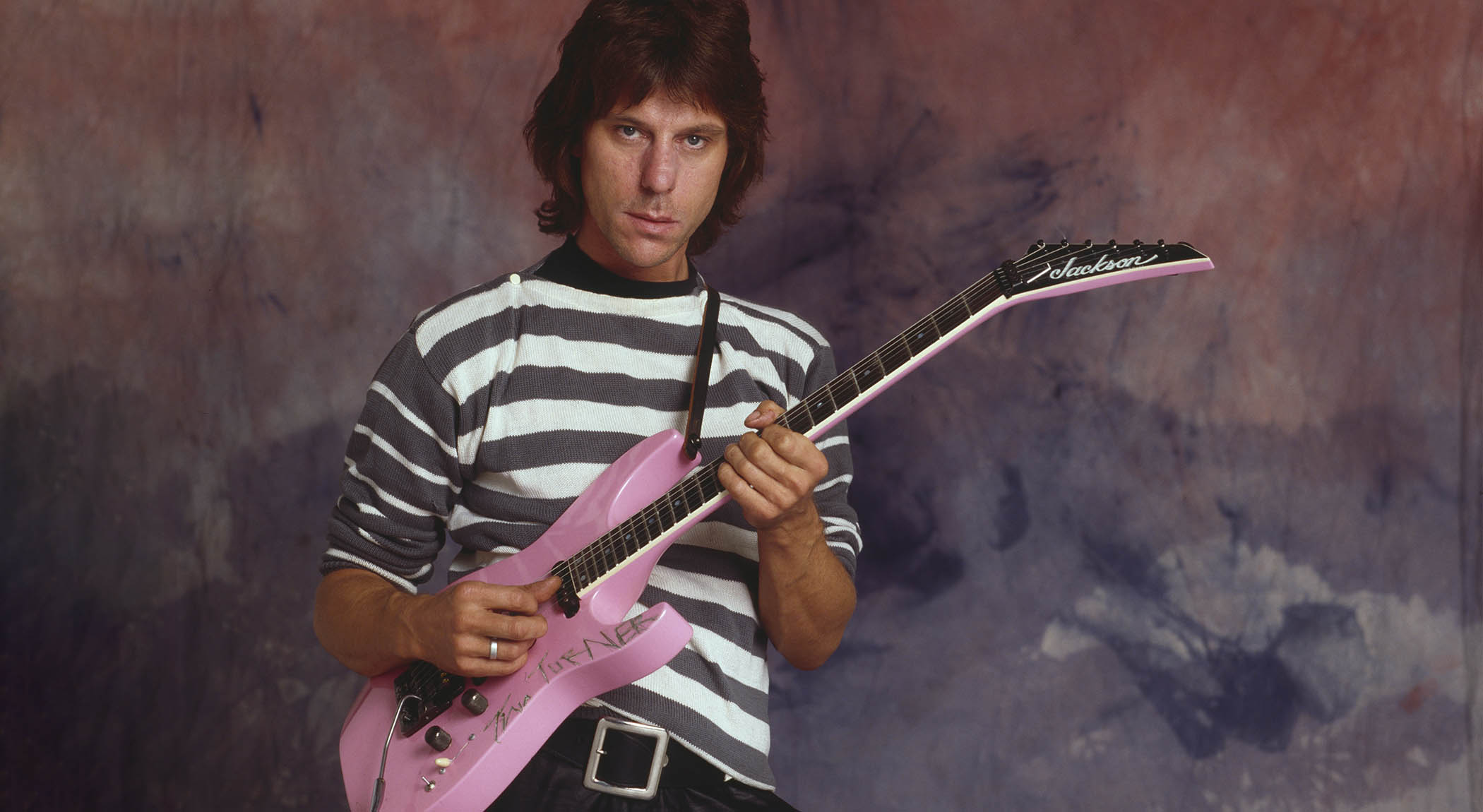
For a very brief period in the mid ’80s, Beck was no longer a Strat cat or a Les Paul man but rather he favored Jackson super strat models, like this hot pink 1983 Jackson Soloist.
Beck brought this guitar to the studio when he guested on Tina Turner’s Private Dancer album. At the end of the sessions, Beck asked Turner to autograph the guitar, and she obliged by pulling out a switchblade and deeply scratching her signature into its top so it would be a permanent addition.
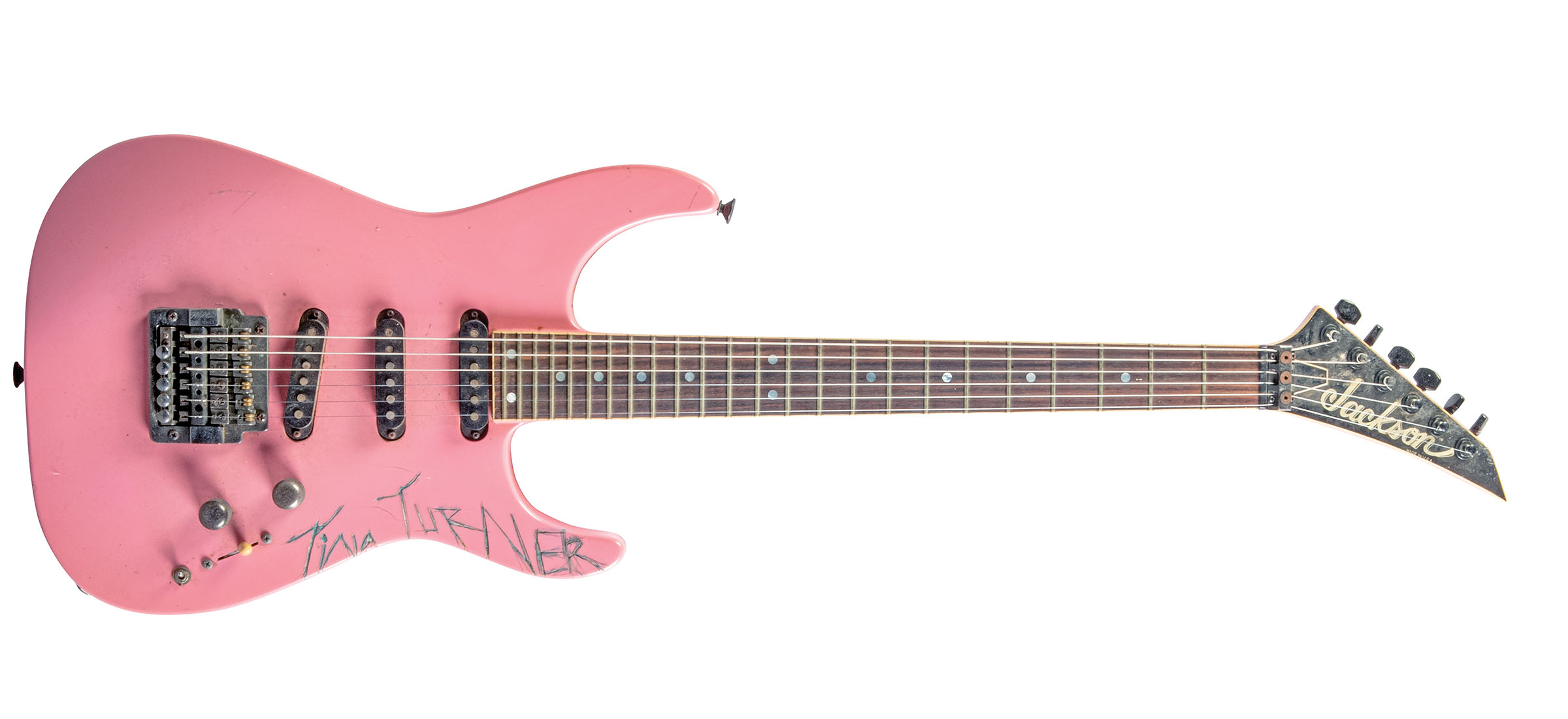
Beck also played this guitar at several ARMS benefit concerts and while recording People Get Ready, his reunion single with Rod Stewart.
C. 1960 Olympic White Fender Stratocaster
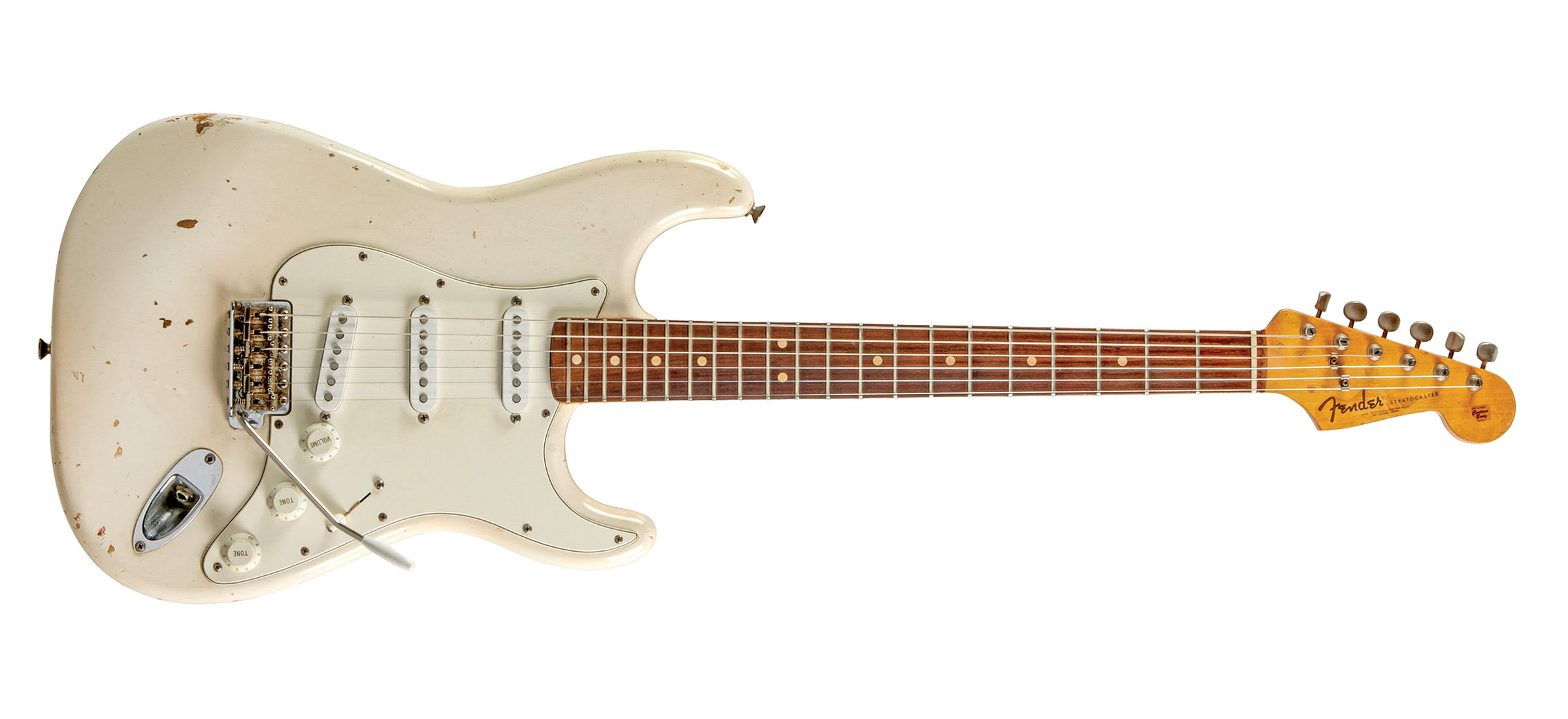
An Olympic White Strat is probably the guitar most closely associated with Jeff Beck. His first one was a brand-new model that he played during the early ’70s. While he was touring with John McLaughlin in 1975, Beck loaned McLaughlin a Gibson Les Paul Deluxe after McLaughlin’s famous custom double-neck Rex Bogue was mysteriously broken in two.
In repayment for the favor, McLaughlin bought Beck a mid-’60s Olympic White Strat from Norman’s Rare Guitars. This is allegedly the white Strat seen on the cover of Beck’s 1976 Wired album.
Unfortunately, the McLaughlin Strat was stolen after Beck absentmindedly left it in an open-top hot rod while he dashed in and out of the Soho London nightclub Ronnie Scott’s. Beck bought a similar replacement, but that was stolen too by shifty airline baggage handlers in the U.S. while he was on tour. Beck promptly bought a third replacement, which is the 1960 model seen here.
This is the same guitar seen in photos of Beck’s 1978 Japan tour with Stanley Clarke where it had a black pickguard with individual on/off switches for each pickup, which were Schecter models wound by Tom Anderson.
That pickguard is still with the guitar but with Seymour Duncan Quarter Pound pickups, along with a white pickguard with custom pickups that Duncan gave to Beck in 1995. The pickups and pickguard currently on the guitar are its stock Sixties parts.
This 1960 Strat appeared on several Beck albums over the years, including Crazy Legs (1993).
1990 Fender Jeff Beck Signature Stratocaster prototype #2
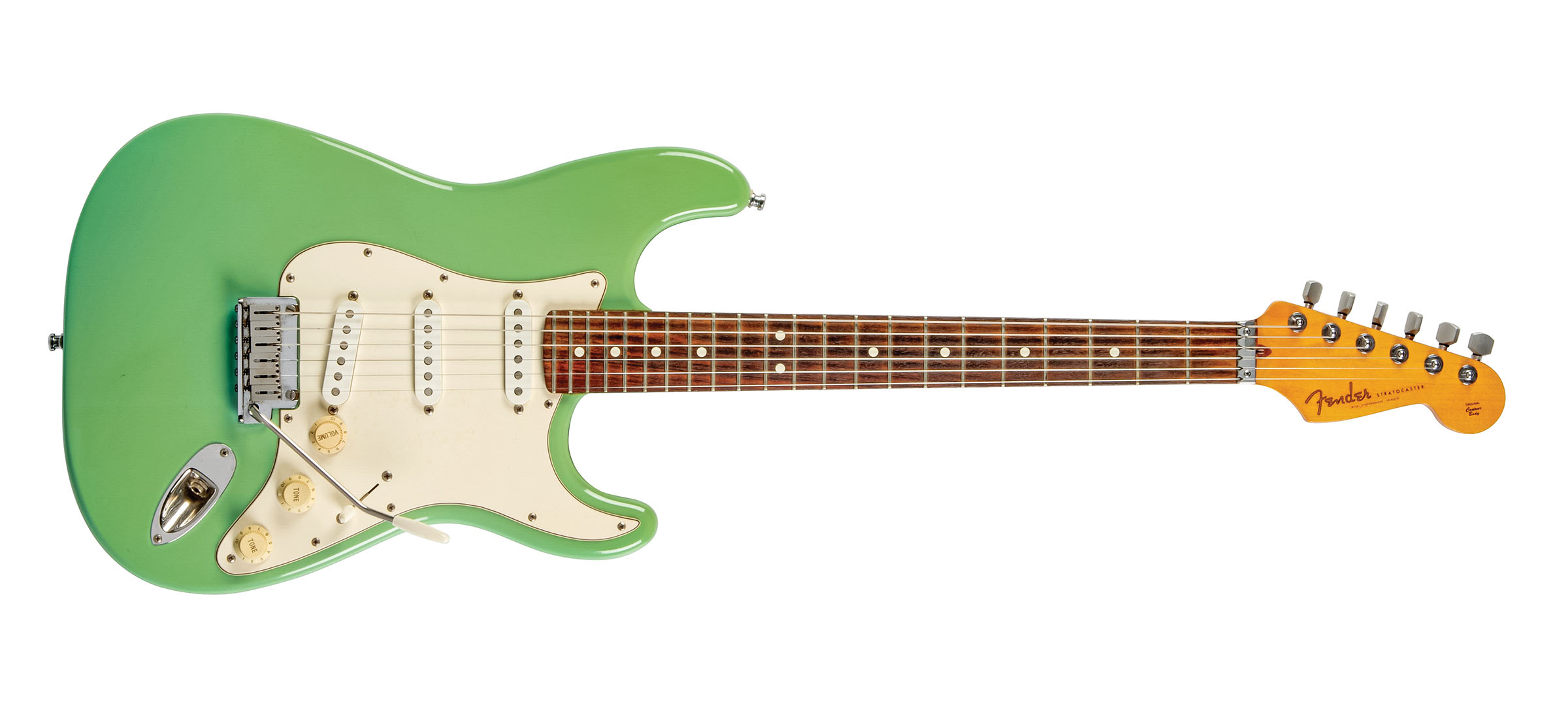
Although Beck was seen on his 1989 tour playing several custom Fender Strat Plus models that were precursors to his signature model, the very first official Jeff Beck Signature Stratocasters were not delivered to Jeff until early 1990 while he was in the studio working on Jon Bon Jovi’s first solo album.
One of those prototypes was a Seafoam Green model that became Jeff’s main Strat through his 1995 tour with Carlos Santana, and it featured Little Richard’s autograph scratched on its top similar to Tina Turner’s autograph. This prototype is #2 and it is almost identical to Beck’s favored “Little Richard” guitar.
1980 Ibanez Jeff Beck Signature prototype

When Beck toured Japan in 1978, numerous Japanese companies approached him about collaborating on a signature guitar. Two unique Greco guitars given to Jeff in 1978 are part of the auction, but even more fascinating are nine Ibanez guitars that include a “limited edition” variant of an MC-400 Musician model and eight prototypes built during 1979 and 1980 that reveal Ibanez’s various and persistent (but ultimately futile) attempts to woo Mr. Beck.
The 1980 prototype seen here is from the very last run of prototypes made in November of that year before Beck ultimately nixed the project.
With its Fender-style tremolo, unorthodox roller string trees that pre-dated the Wilkinson roller nut he favored about a decade later, pair of humbucking pickups, set neck and white finish, it probably came the closest of Ibanez’s numerous attempts to make a Fender/Gibson hybrid that met Beck’s demands.
However, the relatively complicated controls, which included coil-tap and phase switches, a built-in preamp and active EQ, never seemed to appeal much to Jeff.
1956 Gretsch 6128 Duo-Jet

One of the greatest revelations of the Christie’s auction was being able to finally see the progression of Gretsch guitars that Beck purchased while he pursued the sounds of his childhood guitar hero, Cliff Gallup of Gene Vincent and His Blue Caps.
Gallup’s ax was a 1956 Duo Jet with a fixed Bigsby vibrato, but those are as rare as hens’ teeth. Beck did finally manage to get an exact dead ringer in late 1992, but alas, this was just after he had completed his Gallup tribute album, Crazy Legs.
Other Gretsch guitars in the auction include the 1972 Roc Jet that was his first failed attempt at the Gallup sound, a 1955 Duo Jet with a swivel-arm Bigsby purchased in 1984 that was pretty close – and that Beck used on Crazy Legs – and a red 1963 Jet Firebird that is the same exact year and model as Malcolm Young’s number one guitar.
1990/1993 Fender Custom Shop Stratocaster ‘Anoushka’
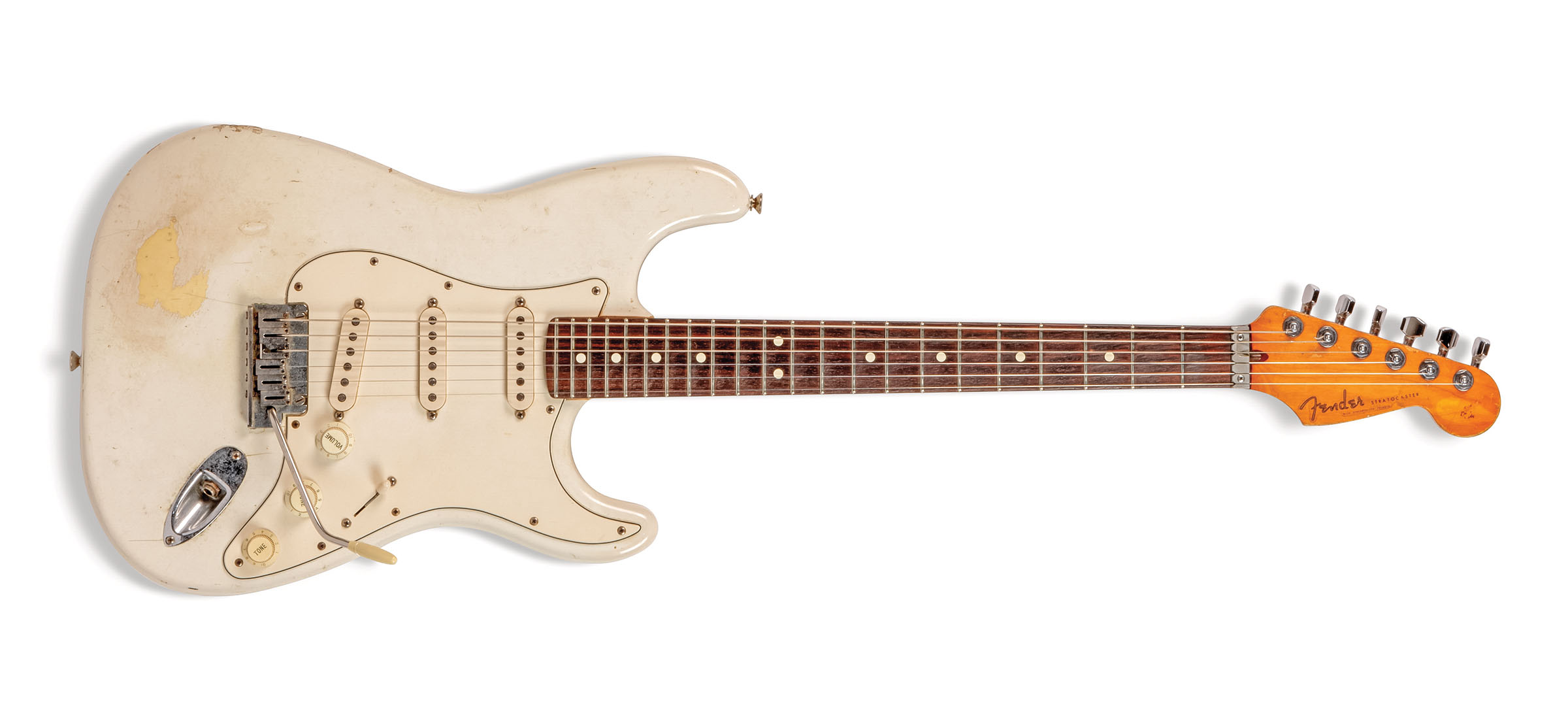
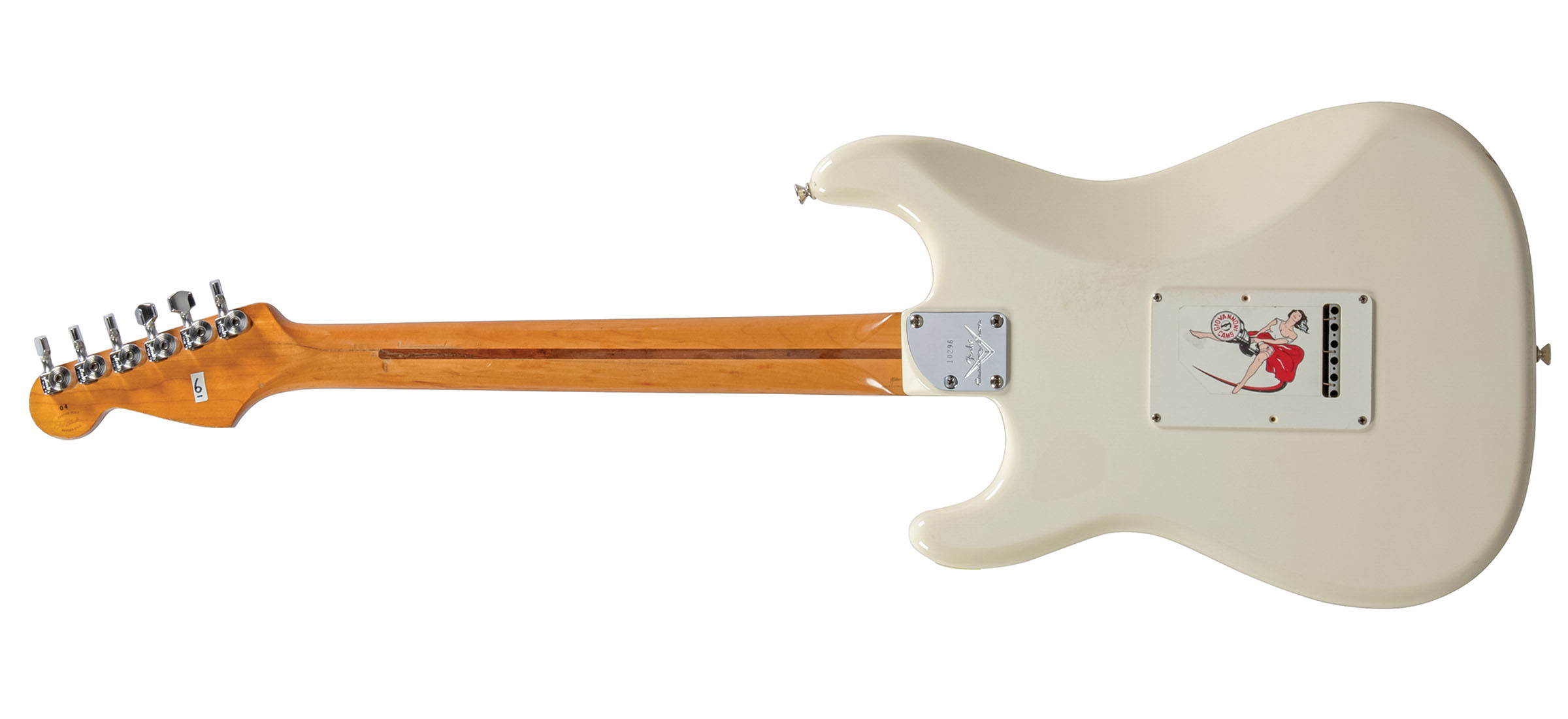
Jeff Beck had numerous instruments that he considered his main guitar over his six-decade career, but none sustained that status longer than a Fender Custom Shop Strat nicknamed ‘Anoushka,’ which was his main guitar for 16 years. It earned its nickname when Anoushka Shankar, sitar virtuoso and daughter of Ravi Shankar, autographed it.
Beck used this guitar to record the Who Else!, You Had It Coming, Jeff and Emotion & Commotion albums and to perform hundreds of concerts, including the Red, White & Blues show alongside B.B. King, Buddy Guy, Mick Jagger and others at the White House on February 21, 2012, in front of President Obama.
c. 1950s Mario Maccaferri G40
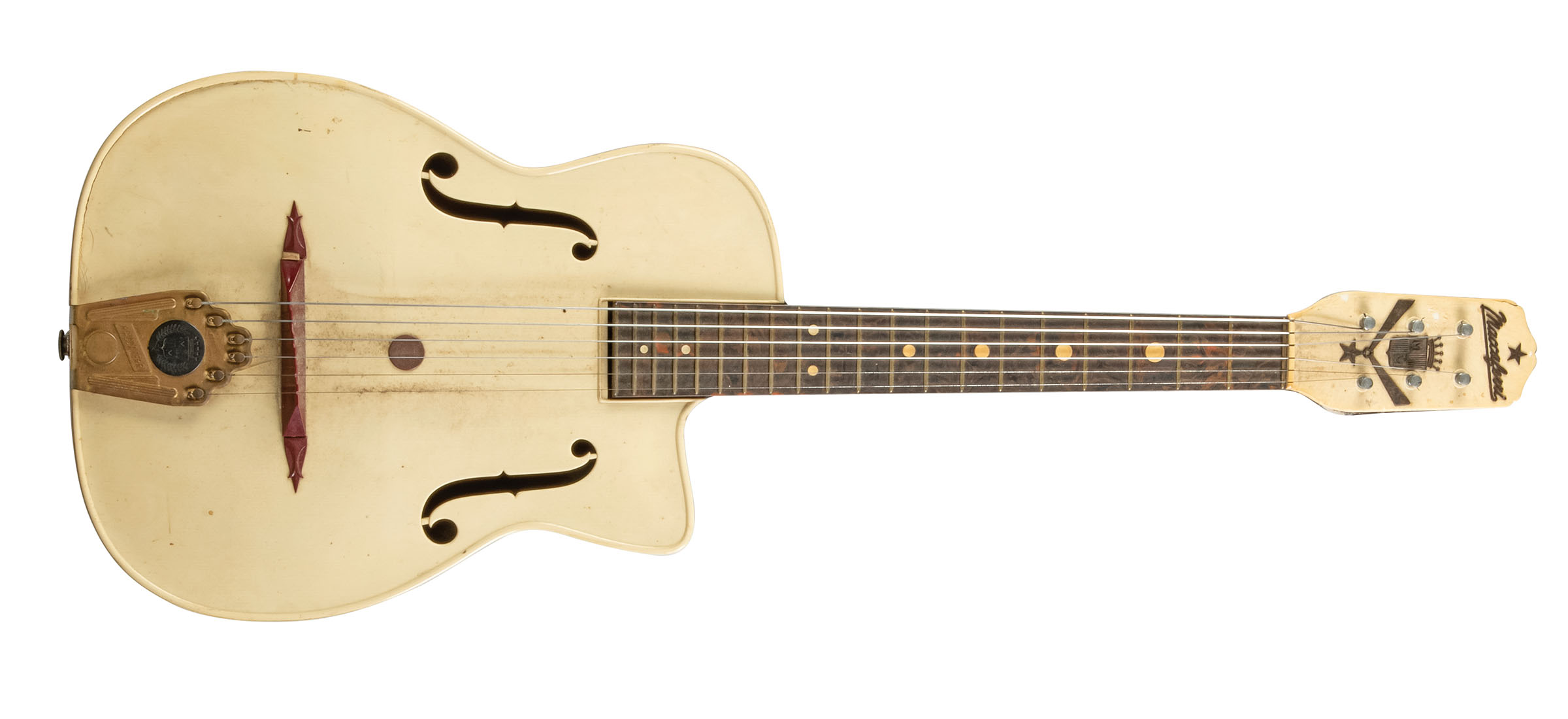
“This is one of my prized possessions given to me by Jimmy Page,” Beck said in a video shot in 2010 that was included with the Rock ’n’ Roll Party (Honoring Les Paul) DVD.
“It’s the same brand of guitar used by the great Django Reinhardt [actually Mario Maccaferri only designed the Selmer Modèle Orchestre guitar with an internal resonator that preceded the Selmer Modèle Jazz guitar that Django played].
“It’s a fantastic, sweet little thing. You can pick it up while you’re watching TV and noodling around. It’s a nice thing to have lurking around and use as an exercise machine. It has a Django sound.”
Maccaferri developed numerous plastic products during the post-World War II years, including clothespins that sold extremely well and made him a fortune.
He also developed a variety of affordable plastic instruments that included the G40 guitar seen here, which originally sold for $39.95 and was produced from 1952 until 1969. Elderly Instruments acquired leftover surplus stock, which they sold during the ’80s and ’90s.
Stage performance pedalboard, 2022 tour
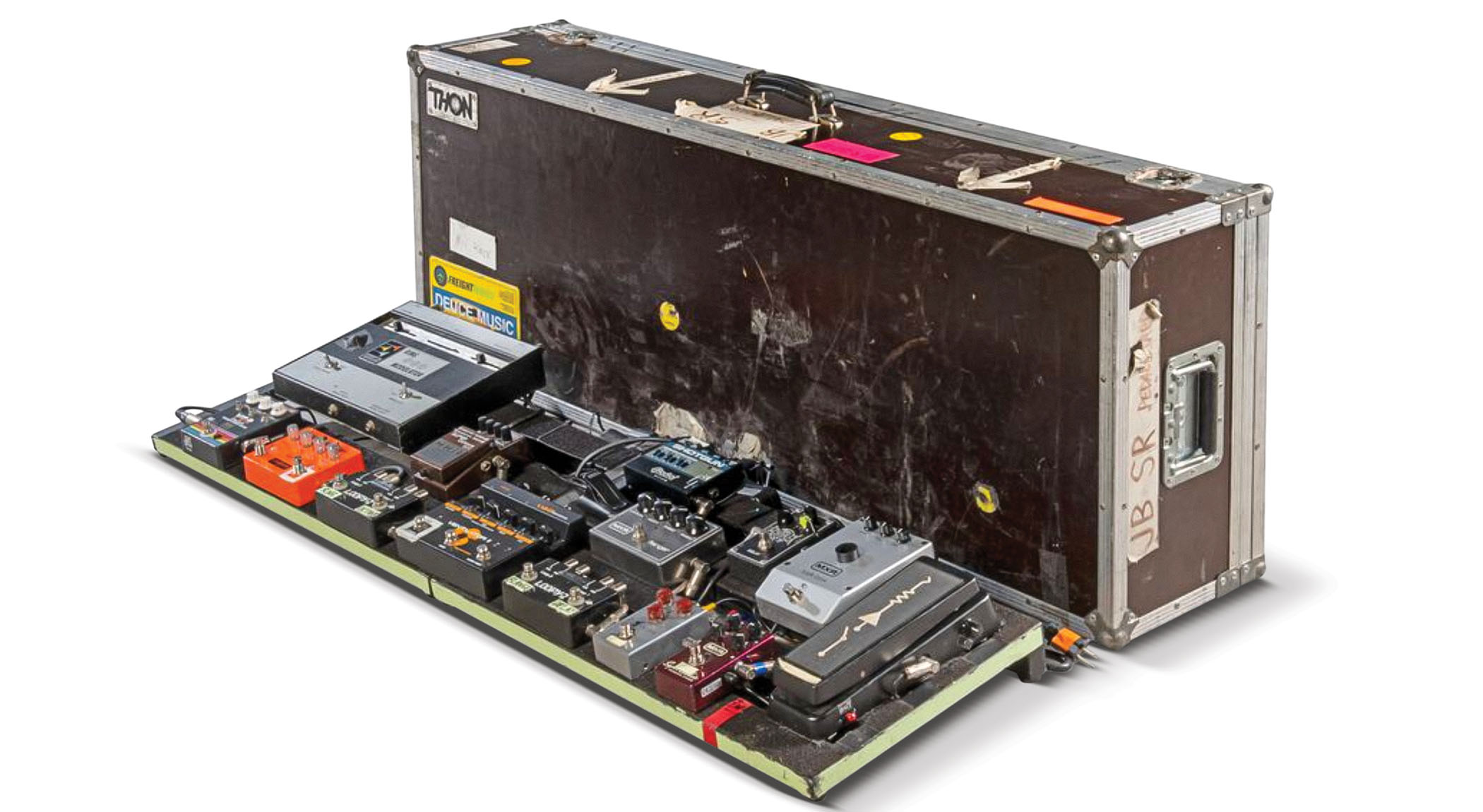
Jeff experimented with pedals often throughout his career – he was even one of the first British guitarists to use a fuzz pedal when he recorded Heart Full of Soul in April 1965 – but he almost never went whole hog when it came to using pedal boards full of effects on stage.
Even in 1989 when he toured in support of his futuristic, high-tech sounding Guitar Shop album, the only effects he had on stage were a humble Rat distortion and a Boss DD-3 digital delay pedal.
Beck’s pedalboard remained pretty low-key even through 2018 when he usually gigged with nothing more than a Klon Centaur, Snarling Dogs Super Bawl Whine-O wah, Hughes & Kettner Rotosphere and Way Huge Aqua Puss analog delay. However, in 2019 his pedalboard suddenly expanded significantly, and on his final 2022 tour it somewhat resembled NASA’s Mission Control.
Beck’s 2022 pedalboard seemed to be configured to cover any sound from any song from his entire career. There’s an MXR M222 Talk Box for effects from his BBA and Blow by Blow era, an original vintage Maestro Ring Modulator for Wired, a Boss OC-3 Super Octave to fill in for his classic Mu-Tron Octave Divider, a Dunlop MC404 Custom Audio Electronics wah and an MXR M236 Super Badass Variac Fuzz to complete the Sixties- and Seventies-era sounds.
On the more modern side of the spectrum are a JHS VCR Signature PaxAm Modulation (with discontinued Ryan Adams graphics) for chorus and reverb, an Empress Effects Tremolo, Neo Instruments Ventilator II rotary cabinet simulator, MXR M117R Flanger and a Dunlop EP103 Echoplex Delay.
A custom J. Rockett Archer boost/overdrive pedal that was a prototype for the limited-edition Archer Jeff pedal with NOS components replaced the Klon Centaur that even Beck considered too expensive and rare to risk losing or damaging while on the road.
Functional accessories include a Radial Engineering Shotgun guitar splitter and buffer for driving several amps at once or freely selecting individual amps, two GigRig Loopy pedals to provide independent loop switching for his ring modulator, octave, flanger and delay pedals and On Stage LED pedalboard lights.
- Read more: What the auction of Jeff Beck’s best-loved electrics tells us about the late guitar icon
- Jeff Beck: The Guitar Collection goes under the hammer in a live auction on 22 January 2025 at Christie’s in London. For more information, see Christie's
Chris is the co-author of Eruption - Conversations with Eddie Van Halen. He is a 40-year music industry veteran who started at Boardwalk Entertainment (Joan Jett, Night Ranger) and Roland US before becoming a guitar journalist in 1991. He has interviewed more than 600 artists, written more than 1,400 product reviews and contributed to Jeff Beck’s Beck 01: Hot Rods and Rock & Roll and Eric Clapton’s Six String Stories.
You must confirm your public display name before commenting
Please logout and then login again, you will then be prompted to enter your display name.
"A guitarist's ticket to easier home recording": PreSonus Quantum HD 2 review
“What blew me away was that everyone wanted the curly maple top. People were calling, saying, ‘I’ve got to have the bird inlays’”: Paul Reed Smith on raising the Standard 24, finally cracking the noise-free guitar and why John Sykes is a tone hero

















